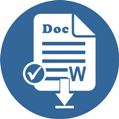Certification of fisheries human rights and its impact to protecting the rights of fishing vessel crew
DOI:
https://doi.org/10.22219/ljih.v29i1.14652Keywords:
Certification, human rights, crew, capture fisheries, protectionAbstract
The crew of fishing vessels is human beings, the absolute owners of human rights that have been universally recognized. To anticipate and overcome many human rights violations in the Indonesian seas, the Government, through the Ministry of Marine Affairs and Fisheries issued a Regulation of the Minister of Marine Affairs and Fisheries Number 35 of 2015 concerning Fisheries Human Rights Systems and Certification. This research further describes how the provisions of the fisheries' human rights certification and analyzes their impact on protecting human rights for fishing vessel crews in Indonesia. The author uses a normative juridical research method by examining library materials or other secondary materials. The data collection method used is a literature study. The tools used are documents in the form of primary, secondary, and non-legal legal materials. The data obtained were analyzed qualitatively and then presented descriptively. This study found that there are various forms of human rights violations against fishing boat crews. Ministry of Marine Affairs and Fisheries then enforces regulation to prevent human rights violations by business actors against fishing vessel crews. There are several weaknesses in regulations and implementations, namely weaknesses in wage system arrangements, limited regulatory targets, the involvement of workers and employers' representatives in the fisheries human rights team that is not clear, weaknesses of the coordinating system for fisheries human rights teams with supervisors employment, weaknesses of fisheries human rights assessment institutions, weaknesses of socialization for employers and workers. The author suggests that it is necessary to strengthen the coordination and cooperation system between ministries in implementing Fisheries Human Rights Regulations. It also needs to improve communication and dissemination of policies and regulations to stakeholders.
Downloads
References
Adam, L. (2017). Kebijakan Perlindungan Pekerja Perikanan Tangkap Indonesia. Kajian, 21(4), 321–338. https://doi.org/10.22212/KAJIAN.V21I4.782
Balik, A. (2016). Tanggungjawab Pengusaha Pelayaran Dalam Perjanjian Kerja Laut (PKL) Terkait Dengan Jam Kerja. Jurnal Sasi, 22(2), 12–20. https://fhukum.unpatti.ac.id/jurnal/sasi/article/view/164/75
Budiono, A., Izziyana, W., & Santoso. (2018). Konsep Etik Perlindungan Hukum Terhadap Profesi Guru. Justitia Jurnal Hukum, 2(2), 224–233. http://journal.um-surabaya.ac.id/index.php/Justitia/article/view/2237
Cahyadi, T. (2017). Perlindungan Hukum Pelaut di Kapal Indonesia Berbasis Nilai Keadilan. Jurnal Pembaharuan Hukum, 4(1), 97. https://doi.org/10.26532/jph.v4i1.1652
Darulzain, M. R., H. M. Kabul Supriyadhie, & Rahayu. (2017). Penerapan Foundational Principles Of The State Duty To Protect Human Rights Dalam United Nations Guiding Principles On Business And Human Rights (UNGP) (Studi terhadap Perlindungan HAM Pekerja di Sektor Perikanan Indonesia). Diponegoro Law Journal, 6(2), 1–16. https://ejournal3.undip.ac.id/index.php/dlr/article/view/19577/18568
Dharmawirawan, D. A., & Modjo, R. (2012). Identifikasi Bahaya Keselamatan dan Kesehatan Kerja pada Penangkapan Ikan Nelayan Muroami. Kesmas: National Public Health Journal, 6(4), 185. https://doi.org/10.21109/kesmas.v6i4.98
Global Slavery Index. (2018). The Global Slavery Index 2018. https://downloads.globalslaveryindex.org/ephemeral/GSI-2018_FNL_190828_CO_DIGITAL_P-1603460367.pdf
Greenpeace, & Serikat Buruh Migran Indonesia. (2019). Seabound: The Journey To Modern Slavery On The High Seas.
ILO. (2015). International Expert Meeting on Labour Exploitation in the Fishing Sector in the Atlantic. http://www.ilo.ch/wcmsp5/groups/public/@ed_norm/@declaration/documents/publication/wcms_429048.pdf
International Labour Organization. (2013, September 13). Pertemuan untuk mengkaji upaya perlindungan pekerja perikanan di kawasan ASEAN. https://www.ilo.org/asia/media-centre/news/WCMS_221452/lang--en/index.htm
Kalu, Y., Kaparang, F. E., & Modaso, V. O. J. (2018). Studi tentang kesehatan dan keselamatan kerja di atas kapal pole and line yang berpangkalan di Aertembaga Bitung (Study on health and safety on pole and liner based in Aertembaga Bitung). Jurnal Ilmu Dan Teknologi Perikanan Tangkap, 2(6). https://doi.org/10.35800/jitpt.2.6.2017.17000
Kolawole, O. D., & Bolobilwe, K. (2019). Survival at a cost: how artisanal fishers perceive occupational hazards in the Okavango Delta, Botswana. South African Geographical Journal, 101(1), 51–71. https://doi.org/10.1080/03736245.2018.1541019
M. Razi Rahman. (2019, October 29). LSM Temukan Masih Ada Awak Kapal Ikan Digaji di Bawah Upah Minimum. https://www.antaranews.com/berita/1136492/lsm-temukan-masih-ada-awak-kapal-ikan-digaji-di-bawah-upah-minimum
Muhamad, S. V. (2016). Illegal Fishing di Perairan Indonesia: Permasalahan dan Upaya Penanganannya Secara Bilateral di Kawasan. Jurnal Politica Dinamika Masalah Politik Dalam Negeri Dan Hubungan Internasional, 3(1), 59–85. https://doi.org/10.22212/JP.V3I1.305
Nakamura, K., Bishop, L., Ward, T., Pramod, G., Thomson, D. C., Tungpuchayakul, P., & Srakaew, S. (2018). Seeing Slavery in Seafood Supply Chains. Science Advances, 4(7), e1701833. https://doi.org/10.1126/sciadv.1701833
Nur, M. (2018). Recommendation for Authorization Overlaping of Placement of Indonesian Fishing Vessels Crews Abroad. Jurnal IUS Kajian Hukum Dan Keadilan, 6(1), 1. https://doi.org/10.29303/ius.v6i1.532
Pratama, M. A. D., Hapsari, T. D., & Triarso, I. (2016). Faktor-Faktor Yang Mempengaruhi Hasil Produksi Unit Penangkapan Purse Seine (Gardan) di Fishing Base PPP Muncar, Banyuwangi, Jawa Timur. Jurnal Saintek Perikanan, 11(2), 120. https://doi.org/10.14710/ijfst.11.2.120-128
Prisnasari, I. (2019). Modern Slavery Pada Anak Buah Kapal (Abk) Perikanan Dalam Perspektif Hak Asasi Manusia. Jurist-Diction, 2(2), 475. https://doi.org/10.20473/jd.v2i2.14229
Putri, D. A. A., & Utomo, T. C. (2019). Kerjasama International Organization for Migration (IOM) dan Pemerintah Indonesia dalam Menangani Perdagangan dan Perbudakan Manusia di Industri Perikanan PT. Pusaka Benjina Resource Tahun 2015. Journal of International Relations, 5(1), 998–1006. http://ejournal-s1.undip.ac.id/index.php/jihiWebsite:http://www.fisip.undip.ac.id/
Riantoro, M. R., Iskandar, B. H., & Purwangka, F. (2018). Potensi Kecelakaan Kerja pada Perikanan Bagan Apung di PPN Palabuhanratu, Jawa Barat. Jurnal Teknologi Perikanan Dan Kelautan, 8(2), 221–236. https://doi.org/10.24319/jtpk.8.221-236
Robin McDowell, Margie Mason, & Martha Mendoza. (2015). AP Investigation: Slaves may have caught the fish you bought | Associated Press. https://www.ap.org/explore/seafood-from-slaves/ap-investigation-slaves-may-have-caught-the-fish-you-bought.html
Santara, A. G., Purwangka, F., & Iskandar, B. H. (2014). Peralatan Keselamatan Kerja Pada Perahu Slerek Di PPN Pengambengan, Kabupaten Jembrana, Bali. Jurnal IPTEKS PSP, 1(1), 53–68.
Soekanto, S., & Mamudji, S. (2015). Penelitian Hukum Normatif : Suatu Tinjauan Singkat (17th ed.). Rajawali Pers.
Suwardjo, D., Haluan, J., Jaya, I., & Poernomo, S. H. (2017). Kajian Tingkat Kecelakaan Fatal, Pencegahan dan Mitigasi Kecelakaan Kapal-Kapal Penangkap Ikan yang Berbasis Operasi Di PPP Tegalsari, PPN Pekalongan dan PPS Cilacap. Jurnal Teknologi Perikanan Dan Kelautan, 1(1), 61–72. https://doi.org/10.24319/jtpk.1.61-72
Verité. (2016). Fishing and Aquaculture, Overview of the Fishing and Aquaculture Sector. http://www.worldwildlife.org/industries/farmed-seafood
Widihastuti, R., & Rosyidah, L. (2018). Sistem Bagi Hasil Pada Usaha Perikanan Tangkap di Kepulauan Aru. Jurnal Kebijakan Sosial Ekonomi Kelautan Dan Perikanan, 8(1), 63. https://doi.org/10.15578/jksekp.v8i1.6859
Wijaya, R. A., & Firdaus, M. (2016). Sistem Perekrutan Pekerja dan Hubungan Kerja pada Usaha Perikanan Tuna. Jurnal Kebijakan Sosial Ekonomi Kelautan Dan Perikanan, 4(1), 1. https://doi.org/10.15578/jksekp.v4i1.28
Downloads
Published
How to Cite
Issue
Section
License
Copyright (c) 2021 Muhammad Nur, M. Hajir Susanto

This work is licensed under a Creative Commons Attribution-ShareAlike 4.0 International License.










